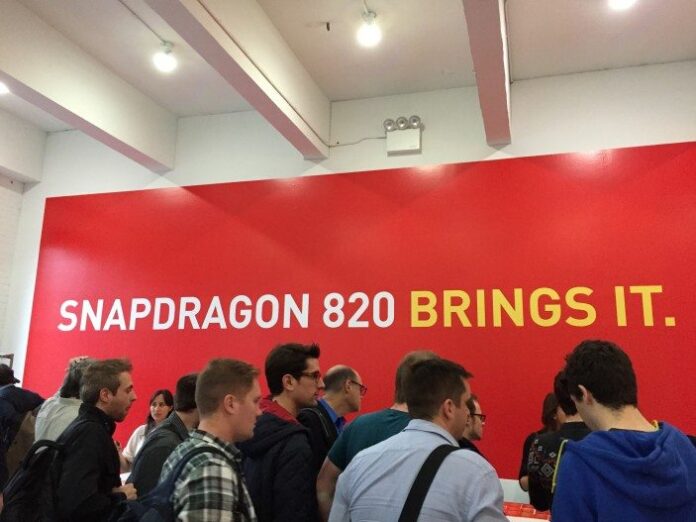New chip supports seamless handoff between LTE, LTE-U and Wi-Fi networks
NEW YORK – Qualcomm is looking to make a splash with its new Snapdragon 820 processor, a chipset that could be used in an array of mobile devices all competing for bandwidth on increasingly congested mobile networks.
To alleviate network congestion and create a higher-quality end-user network experience, Qualcomm said it has built smart high-speed network solutions into their latest processor. The Snapdragon 820 is designed to maintain download speeds of 600 megabits per second, a 33% enhancement over the Snapdragon 810 processor, and upload speeds of 150 Mbps, which is a throughput level 200% higher than the 810.
Sherif Hanna, Qualcomm’s senior technical marketing manager, explained, “This makes the network more efficient, especially in high-capacity events, [like football games] because it allows people to upload and download their data quicker and get off the network.”
Qualcomm’s fast data speeds, according to Hanna, require a clean, strong signal and that’s where 820 and its True Antenna system comes in. Qualcomm said True Antenna combines 820’s more-efficient processor with better software to optimize the signal of a mobile device.
“All this is doing is making the processor talk to the antenna more efficiently,” explained Nitin Dhiman, Qualcomm senior marketing manager.
In doing so, the Snapdragon 820 is able to boost signal strength and increase battery life and efficiency, while also maintaining a strong enough signal to leverage its maximum upload and download speed, enhancing the user experience and increasing the overall efficiency of the entire network.
To further optimize its performance, the 820 also is designed to be interoperable across all wireless systems, whether it’s traditional LTE, LTE-Unlicensed or Wi-Fi. The 820 is designed to seamlessly transition from one system to another, and more importantly, to analyze and recognize which system is stronger in each particular environment.
Qualcomm’s position on 820 is clear: It is designed to be interoperable and high functioning on either the best-built or the most-bare-bones networks.
When asked about the debate between LTE-U and Wi-Fi, Hanna said, “Qualcomm started as a Wi-Fi company and we still are a Wi-Fi company, and our testing shows that LTE-U is a good neighbor for Wi-Fi. In fact, LTE-U is usually a better neighbor to Wi-Fi than Wi-Fi.”
Qualcomm looks toward IoT revolution with new processor
In addition to numerous features that are designed to maximize network efficiency, the 820 processor has numerous built-in systems designed to be leveraged for “Internet of Things” systems. The 820 includes off-line machine learning algorithms that, at the most basic, can be used to classify locations and objects in photos.
A Qualcomm demo operator confirmed the system could easily be upgraded to identify individuals through facial recognition. The 820 is built around the core concepts of maximizing power, efficiency and processing strength. These are two systems that can be crucial to IoT ecosystems that are dependent on being lean yet highly reliable and efficient.
Tim McDonough, VP of marketing at Qualcomm, laid out a grand vision for Qualcomm and the Snapdragon 820, stating he sees the 820 becoming a crucial processor to numerous systems beyond the smartphone.
Qualcomm’s own numbers show by the end of this decade there will be 8.5 billion smartphones shipped globally. Qualcomm has designed its new processor to, in the words of the company’s VP of product management Keith Kressin, “Be great for smartphones, but has a lot of other stuff in there that will be great for other markets.”
Other Qualcomm executives were eager to reiterate that the 820 is a forward-facing chipset, which can be integrated as the base processor for an IoT ecosystem, either in default setting or with optimization. At a roundtable for the press, Qualcomm executives listed a number of IoT verticals they see the 820 being integral to, including drones, connected cars, smart homes, smart cities, and camera and sensor systems.
The 820 also has been designed to function in multiple device networks whether it is an MDN in the single-family home or an office building. Qualcomm has subscribed to the generally accepted notion that the number of connected devices will continue to grow, making it integral that processors are designed around not just being efficient, but also helping to ease congestion. The 820 processors are being touted as integral to future 802.11 Wi-Fi networks, which Qualcomm demo operators said could soon allow 4.6 Gbps data transmission speeds.
McDonough told RCR Wireless News the innovation-focused design mentality was based on having seen Qualcomm’s last generation of processors being used for devices they were never intended for. Qualcomm is now looking to give its potential IoT customers as much flexibility as possible, while at the same time making Qualcomm processors a core component of an industry which could soon be worth trillions of dollars.
Qualcomm paid for travel expenses to this event

